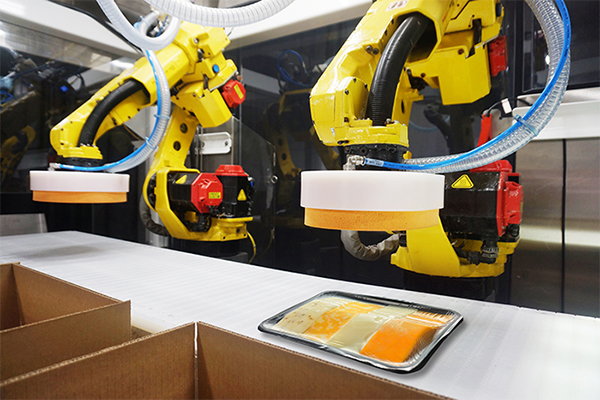
In speaking with many in the packaging industry, we have heard that there are certain unwritten rules regarding robotic automation in packaging. Some of these perceptions include robots don’t like wet environments, flexibles are difficult to handle consistently, there isn’t enough floor space to automate robotics, and more. In talking with customers, CPG integrators, and others who work with robotics, we’ve noticed that Quest, a ProMach product brand, has a very different approach to projects.
First Impressions
1. There isn’t Enough Floorspace to Automate
Industry-wide, the best opportunity to implement robotic machinery is when a new plant is being built or when a new line is created where space isn’t an issue, what some like to call “starting with a clean sheet of paper.” However, this is rarely the case. Being confined to the space of the existing operations often means giving up the rate or some level of automation. It often creates a higher risk factor for the integrator in successfully delivering a robotic cell that performs consistently at the rate, with all of the functionality originally promised.
The Boxed Bot palletizer is a double-decker design that contains an over/under pallet conveyor where empty pallets are supplied on the bottom level while full pallets are discharged on the upper level providing continuous operations without manual interference. All of this within a very small compact footprint.
Similarly, the Quick Pick case packing cell offers tremendous floor space advantages too. Quest can fully utilize the footprint provided, combining operations like case forming within the infeed which are typically separated into separate stations. Working with the customer to understand upstream and downstream operations, Quest ensures the compact cell can easily integrate into the line.
2. Changing “Recipes” Requires Robotic Techs
One of the limiting factors to robotic automation for many companies is access to an experienced robotic technician. The thought of having to contact the robotic integrator every time a pack pattern needs to be updated makes the use of robotics slightly intimidating. In general, the guideline was if you need to make a change after the cell is up and running, only an experienced robotic technician can realize that change for you. That often translates into a paid service call.
At Quest, that guideline is not always true. By recognizing our customers’ need to update production lines based on changes in their customers’ buying behavior or the customers themselves, Quest developed (and continues to develop) HMI software that allows operators to update the “recipes” without the need of an experienced robotic technician. This software is intuitive and easy to use but also protects the user from creating a recipe that will not function correctly. From the QBOX software on a Boxed Bot Palletizer, an operator can update either the pattern for the layer or the overall stack quickly from a drag-and-drop interface. Similar functionality exists on the QPICK software on a Quik Pick Top Load Case Packer. This software provides customers more flexibility and less reliance on a skilled robotic technician.
3. Flexibles are Difficult to Handle Consistently
Most integrators are comfortable with any rigid containers; namely bottles, cans, cartons, or boxes. These containers provide a consistent surface with which the robot can easily predict their interaction. Product in flexible packaging such as bags, pouches, or sachets can often create challenges based on the product contained within it. The product can teardrop or clump together providing an inconsistent surface and/or uneven weight distribution, making each robot pick and place sequence different nearly every time.
At Quest, a large percentage of our business is based on handling difficult-to-handle products like flexibles or even odd-shaped overwrapped products. Through a combination of conditioning, product settling, robotic 2D/3D vision, product orientation, and experience, the team is very successful in creating robotic automation that works consistently and effectively for our customers.
View a flexible bag/pouch line with an interactive flexible line animation which includes Quest’s Boxed Bot, Quik Pick Case Packer, Intelligent Automotive Vehicle (IAV), and more here.
4. Robots Don’t Like Wet Environments
Many of the tough environments such as dairy, produce and raw food, are challenging due to washdown conditions or other sanitation standards that need to be met through the operations and maintenance process. In broad terms, these are damp or downright wet environments. It is challenging to design robotic automation to function consistently and endure in these conditions. The Quest’s Qleen Coat for robots provides a unique advantage in these applications. The coating, paired with our suggested cleaning method, not only protects the robot’s finish but also gives it a bright, quality sheen. The end-user gains the advantage of running a clean system.
5. Robots Aren’t Effective at Higher Speeds
Higher speeds have typically been where the shift between robotic automation and conventional automation happens. The complexity of multiple robots working in tandem and coordinating the actions to achieve the rates increase the project’s risk factor exponentially. This is where most integrators shy away from such a project, believing that robotics just aren’t a good fit.
Quest, on the other hand, is very comfortable with multiple robots in tandem. Quest has successfully designed automation for customers where double-digit robots are side-by-side to achieve those rates. We excel at creating the picking (sequencing) software to coordinate the actions of multiple robots utilizing advanced queue management and load distribution over those same robots.
Closing Thoughts
Through our experience in robotics, out of box thinking to create a solution, and overall enthusiasm around robotic automation, the team at Quest creates truly innovative solutions for our customers.
To read more about Quest and their robotic solutions, watch videos of robotic case packers, palletizers, and more, head to the Quest website: https://www.questindustrial.com/

